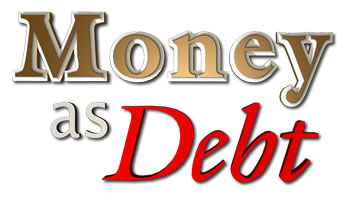|
back / references / reviews |
HOW is Principal Extinguished?The idea that money can be "extinguished" is not intuitively understood by most people. Does somebody burn cash or something like that? For most people, the mental concept of money is that it is a positive thing, probably due to the use of debt-free coins for millennia. This is constantly reinforced by our own experience. We successfully trade paper cash and digits in an "account" for food, shelter etc. just as we once traded gold and silver coins for things. We continue to perceive money as something with a positive lasting physical nature, which it no longer is, in reality. Today's debt-money is a time contract for self-extinguishment, existing for only as long as the debt that created it exists. What do you pay your bank loan with? Probably a check. A check is a claim upon "legal tender on demand" from the bank that issues the check on behalf of its depositor. Only a tiny percentage of the money we use is legal tender, physical cash. Therefore, these promises are, in the aggregate, fraudulent as literal promises of "legal tender" but true as measurements of bank credit "in legal tender units". You, the borrower, by signing a so-called "loan" contract with a bank, have partnered with the bank to acquire purchasing power now, in exchange for a promise to earn it all back (and more, with interest) in the future. Money, as legal tender cash, need not be involved if bank credit functions as money and just uses the "money unit" to quantify the "value" of bank credit. What happens when a $1000 check is cleared through the credit system? 1. The account of the depositor who wrote the check is reduced by $1000. The bank no longer owes that depositor $1000 in "legal tender on demand". Who does the bank owe it to? 2. If the check is written on the same bank as it is deposited at, it is just a liability moved from one account to another. The bank just owes "legal tender" to someone else. No legal tender is required. 3. If the check is written on the same bank as it is deposited at, and it is paying off a loan, the loan account of the borrower is reduced by the Principal portion of the $1000 payment. Let us use 80% Interest, 20% Principal as an example. The loan account is reduced by $200. That borrower owes the bank $200 less than before. Performing loans are bank assets. Therefore, because of this Principal payment, the bank's assets have now been reduced by $200. Deposits are bank liabilities, promises to pay legal tender on demand. The $1000 payment means that $1000 of bank liabilities have been given to the bank. Therefore, the bank's liabilities to other banks have been reduced by $1000. This leaves the bank free to spend the difference, $800, in new liabilities against itself. Most will be spent on operating expenses, capital investments and dividends. 4. If the check is written on a different bank, then the first bank owes the second bank "legal tender on demand". But, over time, if every bank creates credit and gets an equal amount deposited back, all debts between banks can theoretically cancel each other out to zero, just as if there were only one bank. In reality, banks compete for deposits making reality much messier than the theoretical. Nonetheless, only the longer lasting differences need be paid. Therefore, actual settlements between banks are only a small portion of total credit issued. 5. The ASSET of the bank is the fact that the borrower has promised to acquire, return to the bank and extinguish claims against the bank for "legal tender" the bank does not have. With interest, the borrower will give the bank more claims than were created for the borrower (Principal). These extra claims (Interest) are not extinguished. The Interest becomes the bank's spendable income. It is perfectly acceptable to pay this "debt" with bank credit, bank promises of legal tender, not cash. If the loan is paid with cash, the paper cash goes into the bank's cash vault, and if not needed for cash withdrawals, will be traded to another bank for credit, or returned to the central bank for central bank credit, which can also be used to settle accounts with other member banks as part of the check clearing process. In either case, the cash is used to extinguish liabilities against the bank. If the $1000 is paid in cash or by check, the loan account will be reduced by $200, the liabilities against the bank will be reduced by $1000 leaving $800 to be spent by the bank. The "money supply" has been reduced by the $200 of extinguished Principal and, because money IS debt in this system, can only be replaced by someone promising to pay the bank $200, plus interest. site map / view all movies / contact
|
